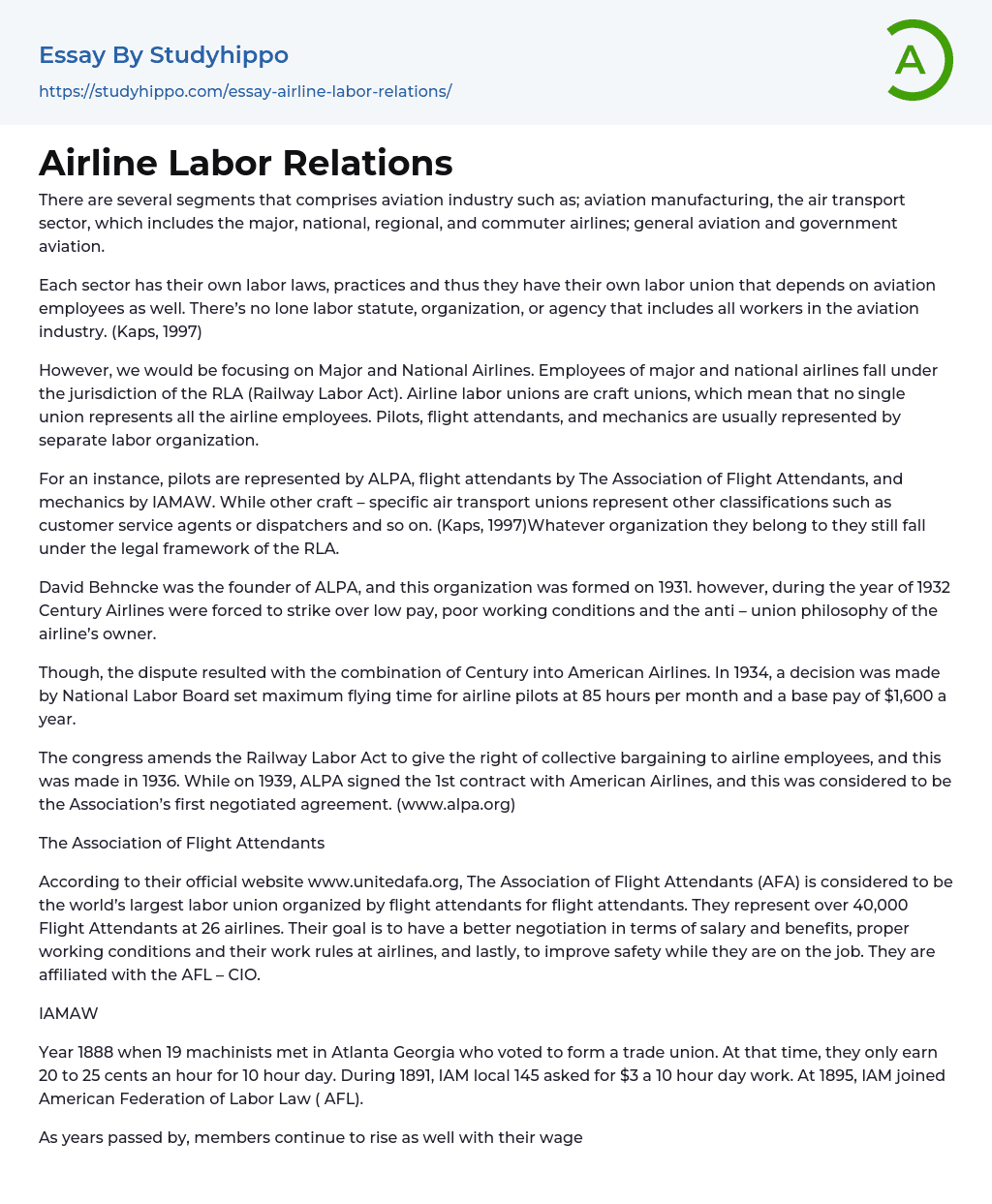There are several segments that comprises aviation industry such as; aviation manufacturing, the air transport sector, which includes the major, national, regional, and commuter airlines; general aviation and government aviation.
Each sector has their own labor laws, practices and thus they have their own labor union that depends on aviation employees as well. There’s no lone labor statute, organization, or agency that includes all workers in the aviation industry. (Kaps, 1997)
However, we would be focusing on Major and National Airlines. Employees of major and national airlines fall under the jurisdiction of the RLA (Railway Labor Act). Airline labor unions are craft unions, which mean that no single union represents all the airline employees. Pilots, flight attendants, and mechanics are usually represented by separate
...labor organization.
For an instance, pilots are represented by ALPA, flight attendants by The Association of Flight Attendants, and mechanics by IAMAW. While other craft – specific air transport unions represent other classifications such as customer service agents or dispatchers and so on. (Kaps, 1997)Whatever organization they belong to they still fall under the legal framework of the RLA.
David Behncke was the founder of ALPA, and this organization was formed on 1931. however, during the year of 1932 Century Airlines were forced to strike over low pay, poor working conditions and the anti – union philosophy of the airline’s owner.
Though, the dispute resulted with the combination of Century into American Airlines. In 1934, a decision was made by National Labor Board set maximum flying time for airline pilots at 85 hours per month and a base pay of $1,600
year.
The congress amends the Railway Labor Act to give the right of collective bargaining to airline employees, and this was made in 1936. While on 1939, ALPA signed the 1st contract with American Airlines, and this was considered to be the Association’s first negotiated agreement. (www.alpa.org)
The Association of Flight Attendants
According to their official website www.unitedafa.org, The Association of Flight Attendants (AFA) is considered to be the world’s largest labor union organized by flight attendants for flight attendants. They represent over 40,000 Flight Attendants at 26 airlines. Their goal is to have a better negotiation in terms of salary and benefits, proper working conditions and their work rules at airlines, and lastly, to improve safety while they are on the job. They are affiliated with the AFL – CIO.
IAMAW
Year 1888 when 19 machinists met in Atlanta Georgia who voted to form a trade union. At that time, they only earn 20 to 25 cents an hour for 10 hour day. During 1891, IAM local 145 asked for $3 a 10 hour day work. At 1895, IAM joined American Federation of Labor Law ( AFL).
As years passed by, members continue to rise as well with their wages. In 1926, congress passes Railway Labor Act which required carrier to bargain and prohibit discrimination against union member. And on 1953, IAM has contracts fixing wages and working conditions with their 13,500 employees. Until now, IAM continues to battle and protests some actions that would not be detrimental to their employees. (http://www.goiam.org/)
Deregulation Impact on Labor Relations
The Airline Deregulation Act of 1978
Congress deregulated
the airline industry in 1978 and this had made into the resolution as The Airline Deregulation Act of 1978. It phased out the government’s control over fares and service and allowed market forces to determine the price and level of domestic airline service in the United States. (Hecker, 2006)
Because of this deregulation act, the airline industry went momentous change. Low cost airlines such as Southwest had faced intense cost pressure. United and US Airways announce bankruptcy and because of this, various bad effects had taken place.
Labor contracts were considered void, and pension plans were terminated as well. Legacy airlines emerged from a regulated environment with relatively high structural costs, driven in part by labor costs, including defined benefit pension plan costs. (Hecker, 2006)
The purpose of Deregulation Act was to allow new and existing airlines to enter and serve any market they wanted. Lowering fares and expanding services will enable them boost competition. Congress has expected that an unregulated industry would attract new airlines and increase competition, thereby benefiting consumers with lower fares and improved service. (Hecker, 2006)
- Profession essays
- Labour Economics essays
- Occupational Safety And Health essays
- Pension essays
- Salary essays
- Strike Action essays
- Wage essays
- Career essays
- Workplace essays
- Homeless essays
- Working Together essays
- Career Path essays
- Hunter essays
- Farmer essays
- Nurse essays
- Pilot essays
- Professionalism essays
- Doctor essays
- Discipline essays
- Police Officer essays
- Labor essays
- Social Work essays
- Model essays
- Architect essays
- Engineer essays
- Administration essays
- Stakeholders essays
- Teamwork essays
- Caregiver essays
- Public Administration essays
- Raising Minimum Wage essays
- Interview essays
- Job Interview essays
- Career Choice essays
- Career Goals essays
- Portfolio essays
- Community Service essays
- Work-Life Balance essays
- Performance Appraisal essays
- Job essays
- Employee essays
- Skills essays
- Service essays
- Vocation essays
- Internship essays
- Work Experience essays
- Duty essays
- Dream Job essays
- Career Plan essays
- Working Time essays




